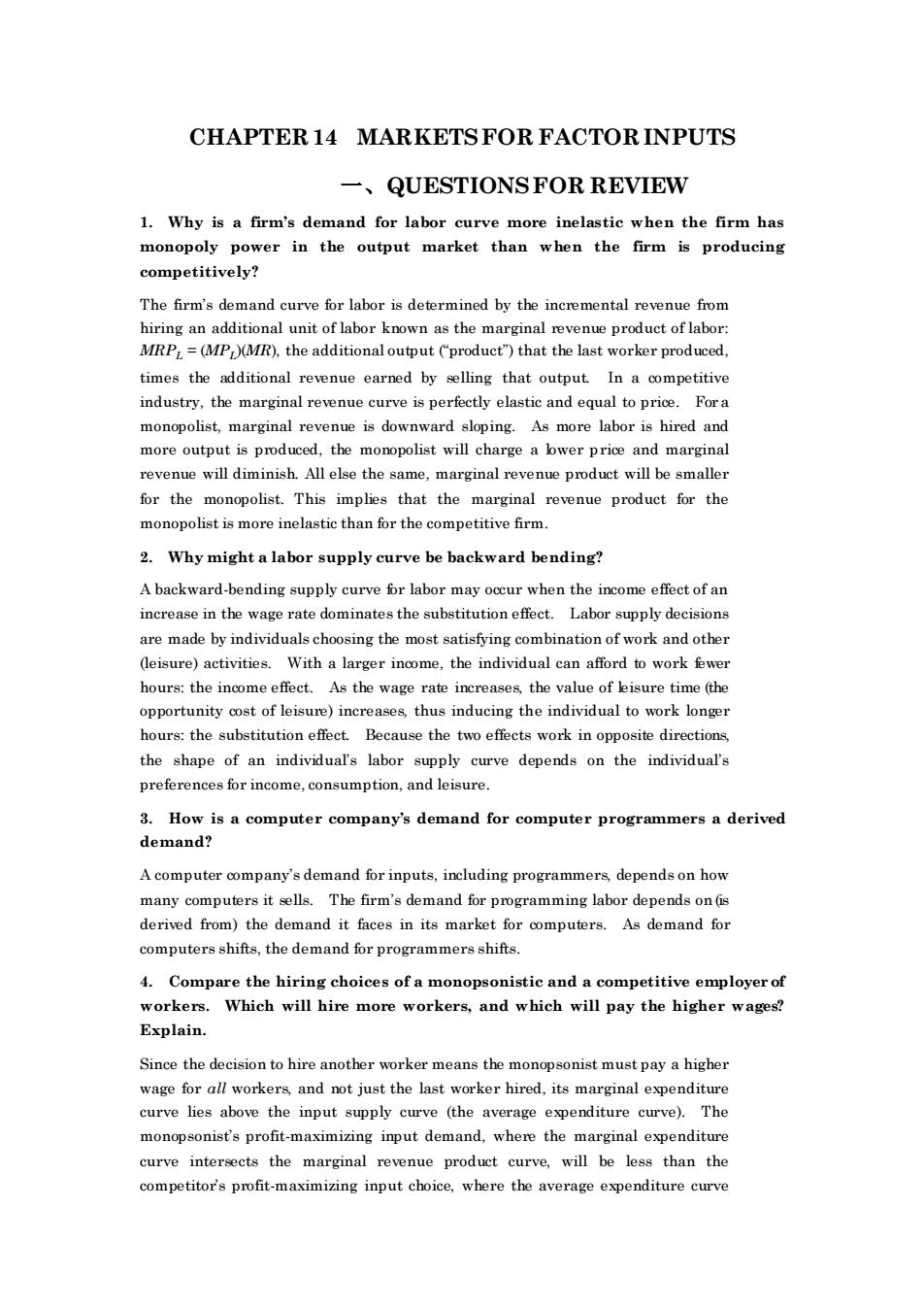
CHAPTER 14 MARKETSFOR FACTOR INPUTS 一、QUESTIONS FOR REVIEW 1.Why is a firm's demand for labor curve more inelastic when the firm has monopoly power in the output market than when the firm is producing competitively? The firm's demand curve for labor is determined by the labor known as the product of ab )the adaoa upu Curduc that the latworker pdu ag出 times the additional revenue earned by selling that output.In a competitive industry.the marginal revenue curve is perfectly elastic and equal to price.Fora monopolist,marginal revenue is downward aloping.Asmore labor is hired and more output i monopolist will charge a bwer price and revenue will diminish.All else the same,marginal revenue product will be smalle for the monopolist.This implies that the marginal revenue product for the monopolist is more inelastic than for the competitive firm. 2.Why might a labor supply curve be backward bending? A backward-bending supply curve for labor may occur when the income effect of an remade by individuals ch leisure)activities. With a larger income,the individual can afford to work fewer hours:the income effect.As the wage rate increases the value of kisure time (the opportunity cost of leisure)increases thus inducing the individual to work longer hours:the substitution effect.Because the two effects work in opposite directions the shape of an individual's labor supply curve depends on the individual's preferences for income,consumption,and leisure. 3.How is a computer company's demand for computer programmers a derived demand? A computer company's demand for inputs,including programmers depends on how many computers it sells.The firm's demand for programming labor depends on (is derived from)the demand it faces in its market for computers.As demand for computers shifts,the demand for programmersshifts 4.Compare the hiring choices of a monopsonistic and a competitive employer workers.Which will hire more workers,and which will pay the higher wages? Explain. Since the decision to hire another worker means the monopsonist must pay a higher wage for all workers and not just the last worker hired,its marginal expenditure curve lies above the input supply curve (the average expenditure curve).The monopsonist's profit-maximizing input demand,where the marginal expenditure curve intersects the marginal revenue product curve,will be less than the competitor's profit-maximizing input choice,where the average expenditure curve
CHAPTER 14 MARKETS FOR FACTOR INPUTS 一、QUESTIONS FOR REVIEW 1. Why is a firm’s demand for labor curve more inelastic when the firm has monopoly power in the output market than when the firm is producing competitively? The firm’s demand curve for labor is determined by the incremental revenue from hiring an additional unit of labor known as the marginal revenue product of labor: MRPL = (MPL)(MR), the additional output (“product”) that the last worker produced, times the additional revenue earned by selling that output. In a competitive industry, the marginal revenue curve is perfectly elastic and equal to price. For a monopolist, marginal revenue is downward sloping. As more labor is hired and more output is produced, the monopolist will charge a lower price and marginal revenue will diminish. All else the same, marginal revenue product will be smaller for the monopolist. This implies that the marginal revenue product for the monopolist is more inelastic than for the competitive firm. 2. Why might a labor supply curve be backward bending? A backward-bending supply curve for labor may occur when the income effect of an increase in the wage rate dominates the substitution effect. Labor supply decisions are made by individuals choosing the most satisfying combination of work and other (leisure) activities. With a larger income, the individual can afford to work fewer hours: the income effect. As the wage rate increases, the value of leisure time (the opportunity cost of leisure) increases, thus inducing the individual to work longer hours: the substitution effect. Because the two effects work in opposite directions, the shape of an individual’s labor supply curve depends on the individual’s preferences for income, consumption, and leisure. 3. How is a computer company’s demand for computer programmers a derived demand? A computer company’s demand for inputs, including programmers, depends on how many computers it sells. The firm’s demand for programming labor depends on (is derived from) the demand it faces in its market for computers. As demand for computers shifts, the demand for programmers shifts. 4. Compare the hiring choices of a monopsonistic and a competitive employer of workers. Which will hire more workers, and which will pay the higher wages? Explain. Since the decision to hire another worker means the monopsonist must pay a higher wage for all workers, and not just the last worker hired, its marginal expenditure curve lies above the input supply curve (the average expenditure curve). The monopsonist’s profit-maximizing input demand, where the marginal expenditure curve intersects the marginal revenue product curve, will be less than the competitor’s profit-maximizing input choice, where the average expenditure curve
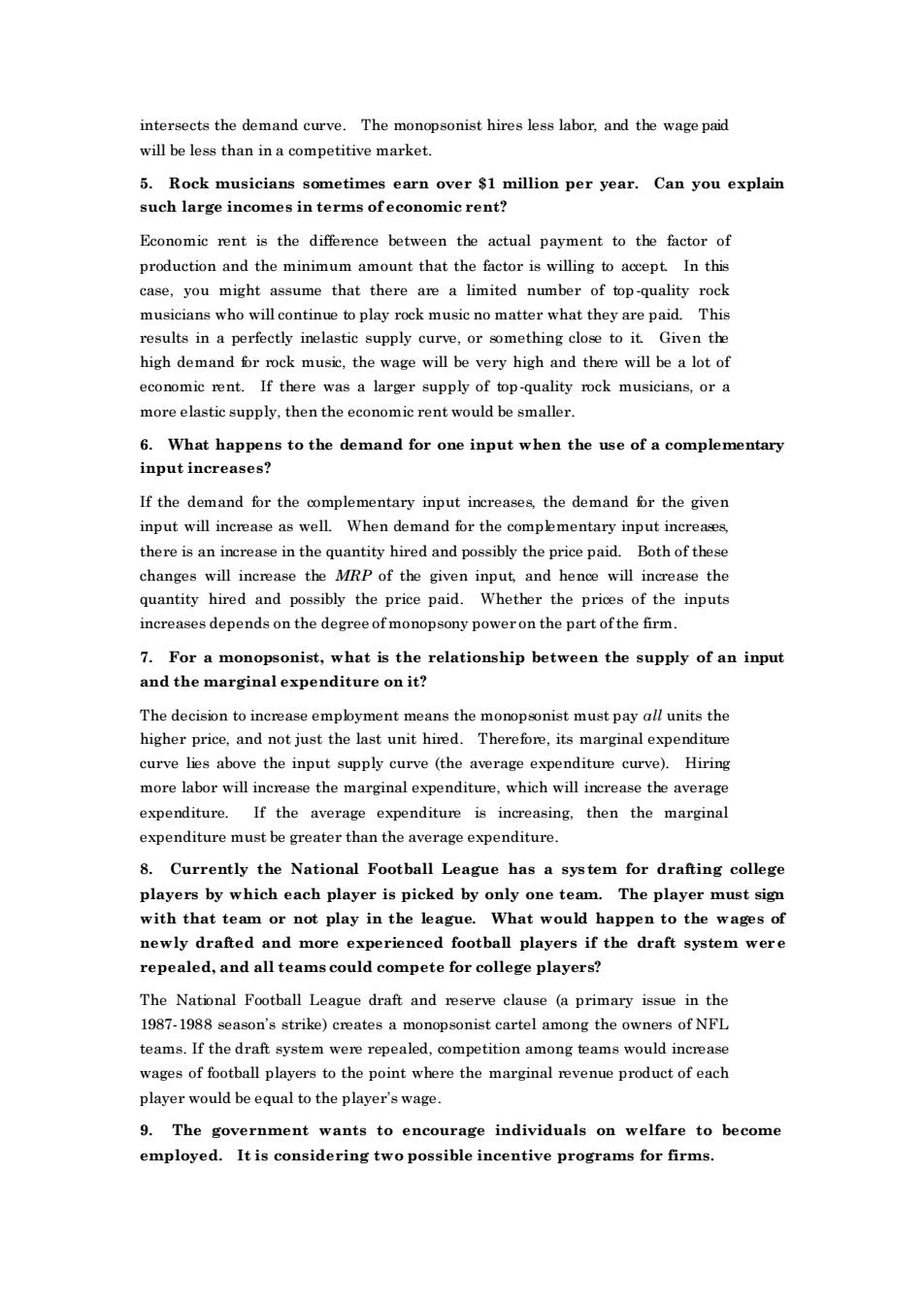
intersects the demand curve.The monopsonist hires less labor,and the wage paid will be less than ina competitive market. 5.Rock musicians sometimes earn over s1 million per year.Can you explain such large incomes in terms ofeconomic rent? Economic rent is the difference between the actual payment to the factor of production and the minimum amount that the factor is willing to accept In this case,you might assume that there are a limited number of top-quality rock musicians who will continue to play rock music no matter what they are paid.This supply CU rve,or something close to it Given the high demand music,the wage will be ery high and there will be a lot of economic rent.If there was a larger supply of top-quality rock musicians,or a more elastic supply,then the economic rent would be smaller. 6.What happens to the demand for one input when the use of a complementary input increases? If the demand for the complementary input increases,the demand for the given input will inerease as well.When demand for the compmentary input there is an increase in the e quantity hir ed and possibly the price paid Both of thes changes will increase the MRP of the given input,and hence will increase the quantity hired and possibly the price paid.Whether the prices of the inputs increases depends on the degree of monopsony poweron the part of the firm. 7.For a monopsonist,what is the relationship between the supply of an input and the marginal expenditure on it? The decision to increase empbyr sonist must pay all units the highe and not just the expe curve lies above the input supply curve (the average expenditure curve).Hiring more labor will increase the marginal expenditure,which will increase the average expenditure.If the average expenditure is increasing.then the marginal expenditure must be greater than the average expenditure 8.Currently the National Football League has a system for drafting college players by which each player is picked by only one t The player must sign with that team or not play in the league.What would happen to the wages of newly drafted and more experienced football players if the draft system were repealed,and all teams could compete for college players? The National Football League draft and reserve clause (a primary issue in the 1987-1988 season's strike)creates a monopsonist cartel among the owners of nel teams.If the draft system we rerepealed,competition among teams would inereas wages of football players to the point where the marginal evenue product of eac player would be equal to the player's wage. 9.The government wants to encourage individuals on welfare to become employed.It is considering two possible incentive programs for firms
intersects the demand curve. The monopsonist hires less labor, and the wage paid will be less than in a competitive market. 5. Rock musicians sometimes earn over $1 million per year. Can you explain such large incomes in terms of economic rent? Economic rent is the difference between the actual payment to the factor of production and the minimum amount that the factor is willing to accept. In this case, you might assume that there are a limited number of top-quality rock musicians who will continue to play rock music no matter what they are paid. This results in a perfectly inelastic supply curve, or something close to it. Given the high demand for rock music, the wage will be very high and there will be a lot of economic rent. If there was a larger supply of top-quality rock musicians, or a more elastic supply, then the economic rent would be smaller. 6. What happens to the demand for one input when the use of a complementary input increases? If the demand for the complementary input increases, the demand for the given input will increase as well. When demand for the complementary input increases, there is an increase in the quantity hired and possibly the price paid. Both of these changes will increase the MRP of the given input, and hence will increase the quantity hired and possibly the price paid. Whether the prices of the inputs increases depends on the degree of monopsony power on the part of the firm. 7. For a monopsonist, what is the relationship between the supply of an input and the marginal expenditure on it? The decision to increase employment means the monopsonist must pay all units the higher price, and not just the last unit hired. Therefore, its marginal expenditure curve lies above the input supply curve (the average expenditure curve). Hiring more labor will increase the marginal expenditure, which will increase the average expenditure. If the average expenditure is increasing, then the marginal expenditure must be greater than the average expenditure. 8. Currently the National Football League has a sys tem for drafting college players by which each player is picked by only one team. The player must sign with that team or not play in the league. What would happen to the wages of newly drafted and more experienced football players if the draft system were repealed, and all teams could compete for college players? The National Football League draft and reserve clause (a primary issue in the 1987-1988 season’s strike) creates a monopsonist cartel among the owners of NFL teams. If the draft system were repealed, competition among teams would increase wages of football players to the point where the marginal revenue product of each player would be equal to the player’s wage. 9. The government wants to encourage individuals on welfare to become employed. It is considering two possible incentive programs for firms
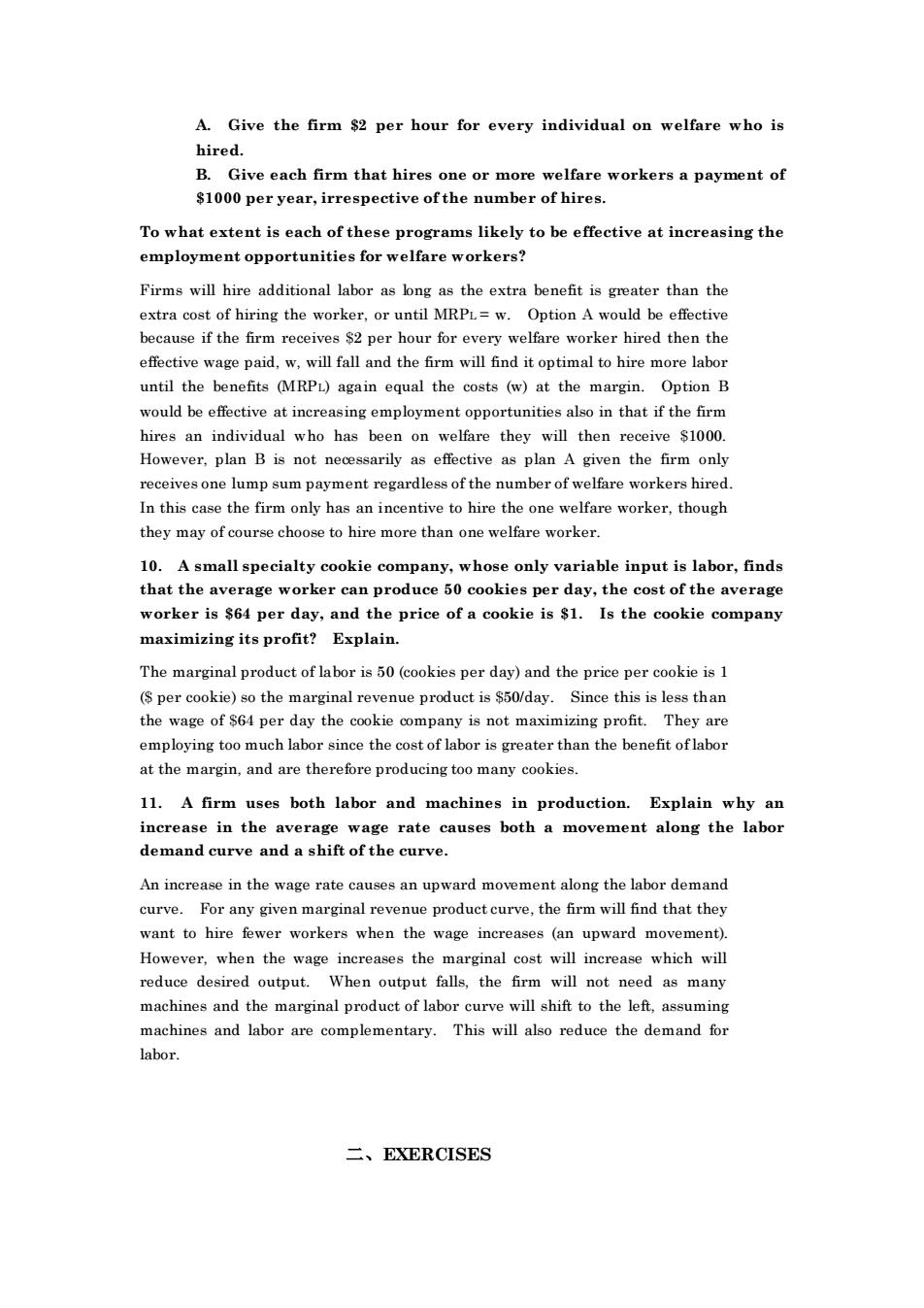
A.Give the firm $2 per hour for every individual on welfare who is hired. B.Give each firm that hires one or more welfare workers a payment of $1000 per year,irrespective of the number of hires. To what extent is each of these programs likely to be effective at increasing the employment opportunities for welfare workers? Firms will hire additional labor as long as the extra benefit is greater than the extra cost of hiring the worker,or until MRP=w.Option A w use if the recei $2 p er h effective wage paid,w,will fall and the firm will find it optimal to hire more labor until the benefits (MRPL)again equal the costs (w)at the margin.Option B would be effective at increasing employment opportunities also in that if the firm hires an individual who has been on welfare they will then receive $1000 lan Ag时 n the firm receivesone lump sum payment regardless of the number of efare workershire In this case the firm only has an incentive to hire the one welfare worker,though they may of course choose to hire more than one welfare worker. 10.A small specialty cookie company.whose only variable input is labor.finds that the average worker can produce 50 cookies per day,the cost of the average worker is $64 per day,and the price of a cookie is $1.Is the cookie company maximizing its profit? Explain. The marginal product of labor is50(cookies per day)and the price per cookie is (S per cookie)so the marginal revenue product is $50/day.Since this is less than the wage of $64 per day the cookie company is not maximizing profit.They are employing too much labor since the cost of labor is greater than the benefit of labor at the margin,and are therefore producing too many cookies. 11.A firm uses both labor and machines in production.Explain why an increase in the avera e rate causes both a movement along the labor demand curve and a shift of the curve. An increase in the wage rate causes an upward movement along the labor demand curve.For any given marginal revenue product curve.the firm will find that they want to hire fewer workers when the wage increases (an upward movement). output Wher output falls,the firm will no ed as man machines and the marginal product of labor curve will shift to the left,assuming machines and labor are complementary.This will also reduce the demand for labor. 二、EXERCISES
A. Give the firm $2 per hour for every individual on welfare who is hired. B. Give each firm that hires one or more welfare workers a payment of $1000 per year, irrespective of the number of hires. To what extent is each of these programs likely to be effective at increasing the employment opportunities for welfare workers? Firms will hire additional labor as long as the extra benefit is greater than the extra cost of hiring the worker, or until MRPL = w. Option A would be effective because if the firm receives $2 per hour for every welfare worker hired then the effective wage paid, w, will fall and the firm will find it optimal to hire more labor until the benefits (MRPL) again equal the costs (w) at the margin. Option B would be effective at increasing employment opportunities also in that if the firm hires an individual who has been on welfare they will then receive $1000. However, plan B is not necessarily as effective as plan A given the firm only receives one lump sum payment regardless of the number of welfare workers hired. In this case the firm only has an incentive to hire the one welfare worker, though they may of course choose to hire more than one welfare worker. 10. A small specialty cookie company, whose only variable input is labor, finds that the average worker can produce 50 cookies per day, the cost of the average worker is $64 per day, and the price of a cookie is $1. Is the cookie company maximizing its profit? Explain. The marginal product of labor is 50 (cookies per day) and the price per cookie is 1 ($ per cookie) so the marginal revenue product is $50/day. Since this is less than the wage of $64 per day the cookie company is not maximizing profit. They are employing too much labor since the cost of labor is greater than the benefit of labor at the margin, and are therefore producing too many cookies. 11. A firm uses both labor and machines in production. Explain why an increase in the average wage rate causes both a movement along the labor demand curve and a shift of the curve. An increase in the wage rate causes an upward movement along the labor demand curve. For any given marginal revenue product curve, the firm will find that they want to hire fewer workers when the wage increases (an upward movement). However, when the wage increases the marginal cost will increase which will reduce desired output. When output falls, the firm will not need as many machines and the marginal product of labor curve will shift to the left, assuming machines and labor are complementary. This will also reduce the demand for labor. 二、EXERCISES
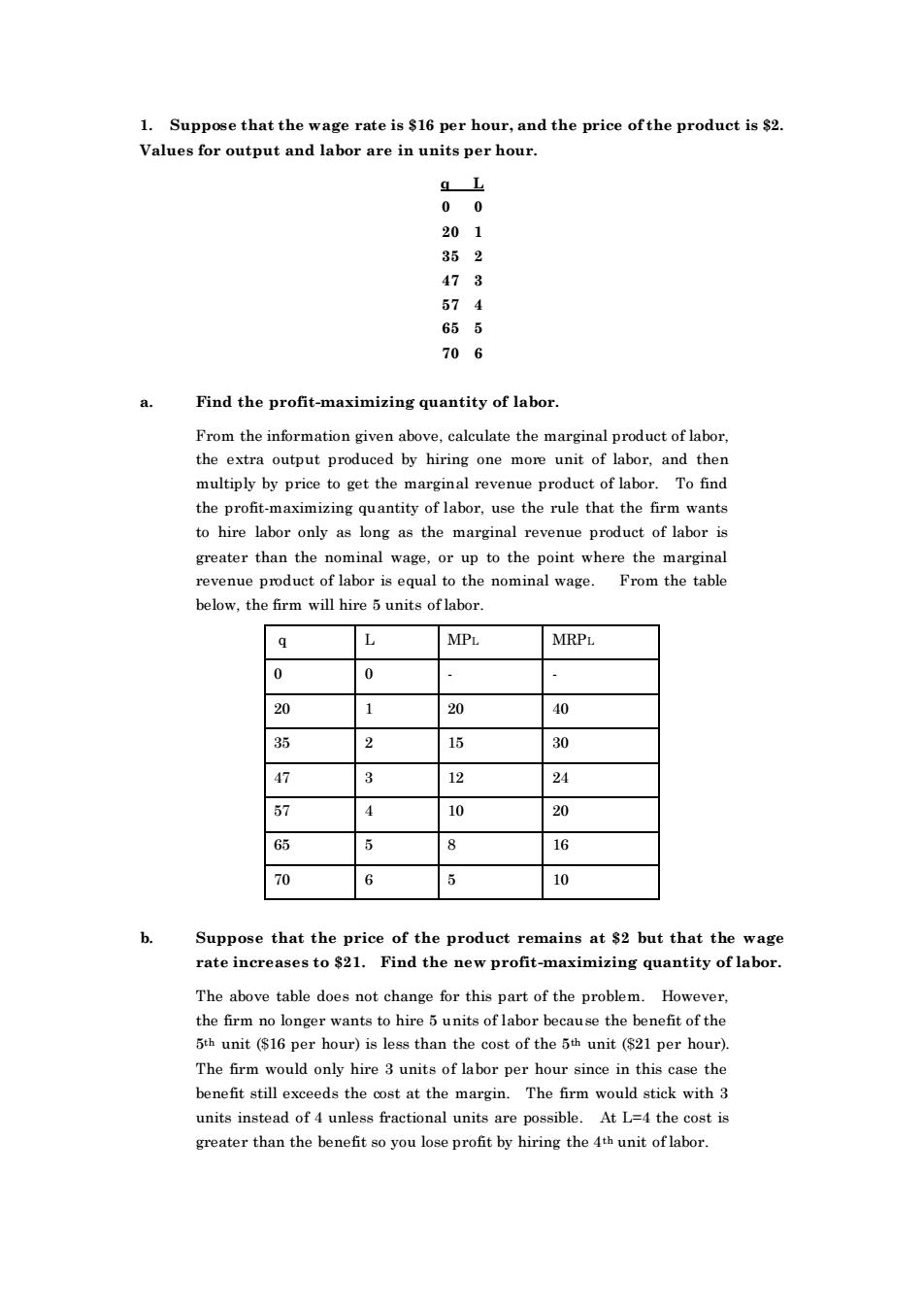
1.Suppose that the wage rate is $16 per hour,and the price ofthe product is $2. Values for output and labor are in units per hour. 201 352 473 574 655 6 Find the profit-maximizing quantity of labor. From the information given above,calculate the marginal product of labor the extra output produced by hiring one more unit of labor,and then multiply by price to get the marginal revenu e product of labor.To find the profit-maximizing quantity of labor,use the rule that thefirm wante to hire labor only as long as the marginal revenue product of labor is greater than the nominal wage.or up to the point where the marginal revenue product of labor is equal to the nominal wage. From the table below,the firm will hire 5 units oflabor L MPL MRPL 0 20 40 2 6 动 47 3 12 24 57 10 20 65 16 70 6 10 Supp se that the rice of the produet remains at $2 but that the wag rate increases to $21 1.Find the new profit-maximizing quantity of labo The above table does not change for this part of the problem. However the firm no longer wants to hire 5 units of labor because the benefit of the 5th unit ($16 per hour)is less than the cost of the 5t unit ($21 per hour). The firm would only hire 3 units of labor per hour since in this case the benefit still exceeds the ost at the margin The6rm would stick with 3 units instead of 4 unless fractional units are possible.At L=4 the cost is greater than the benefit so you lose profit by hiring the 4th unit of labor
1. Suppose that the wage rate is $16 per hour, and the price of the product is $2. Values for output and labor are in units per hour. q L 0 0 20 1 35 2 47 3 57 4 65 5 70 6 a. Find the profit-maximizing quantity of labor. From the information given above, calculate the marginal product of labor, the extra output produced by hiring one more unit of labor, and then multiply by price to get the marginal revenue product of labor. To find the profit-maximizing quantity of labor, use the rule that the firm wants to hire labor only as long as the marginal revenue product of labor is greater than the nominal wage, or up to the point where the marginal revenue product of labor is equal to the nominal wage. From the table below, the firm will hire 5 units of labor. q L MPL MRPL 0 0 - - 20 1 20 40 35 2 15 30 47 3 12 24 57 4 10 20 65 5 8 16 70 6 5 10 b. Suppose that the price of the product remains at $2 but that the wage rate increases to $21. Find the new profit -maximizing quantity of labor. The above table does not change for this part of the problem. However, the firm no longer wants to hire 5 units of labor because the benefit of the 5th unit ($16 per hour) is less than the cost of the 5th unit ($21 per hour). The firm would only hire 3 units of labor per hour since in this case the benefit still exceeds the cost at the margin. The firm would stick with 3 units instead of 4 unless fractional units are possible. At L=4 the cost is greater than the benefit so you lose profit by hiring the 4th unit of labor
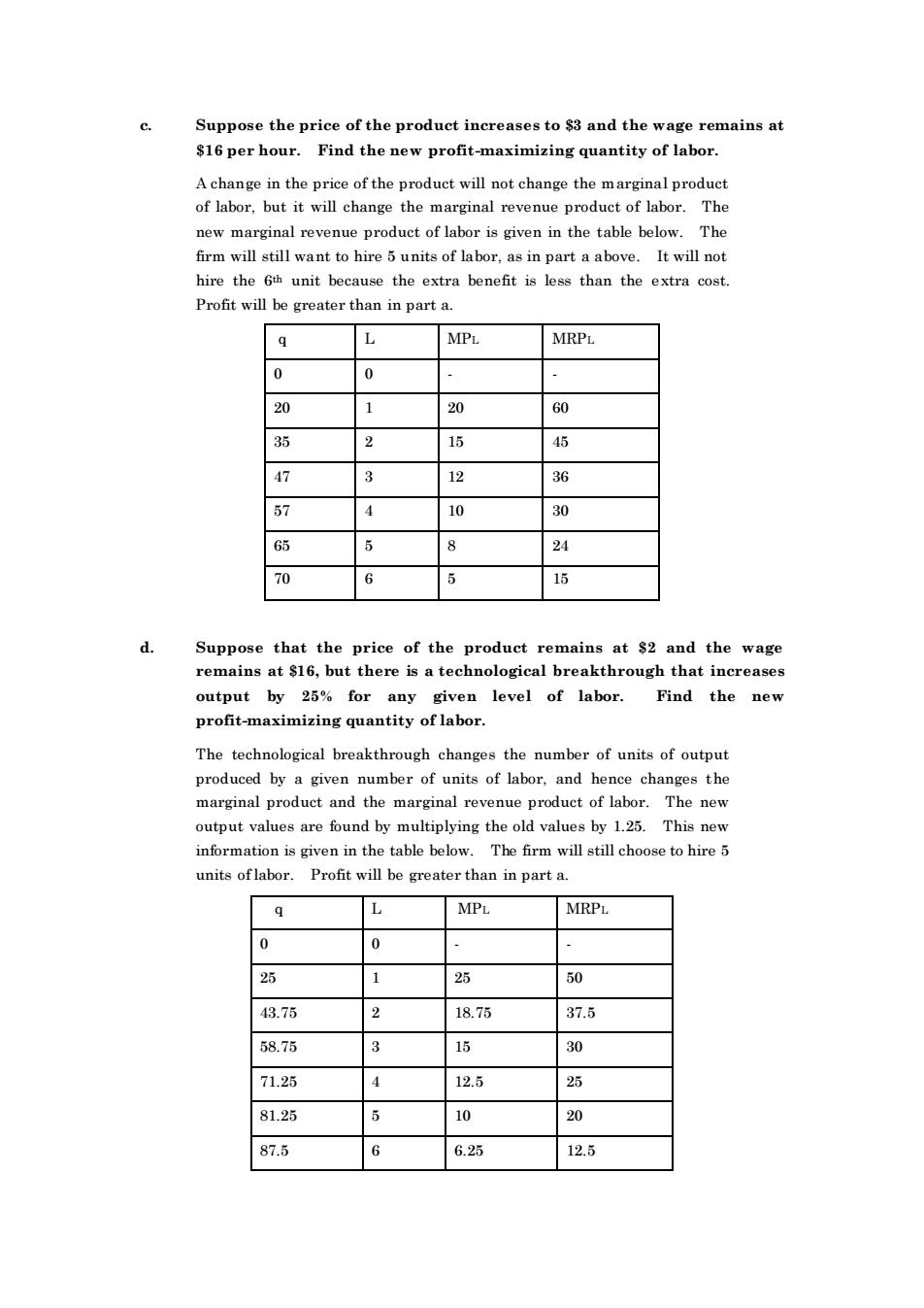
Suppose the price of the product increases to $3 and the wage remains at $16 per hour. Find the new profit-maximizing quantity of labor price of the product will not change the marginal produc change theardt The new marginal revenue product of labor is given in the table below.The firm will still want to hire 5 units of labor,as in part a above.It will not hire the 6th unit because the extra benefit is less than the extra cost. Profit will be greater than in part a. L MPL MRPL 20 60 35 2 15 45 47 3 12 36 57 4 10 30 65 24 70 15 that the price of the oduct remains at $2 and the wag rem $16 h that increa output by 25%for any given level of labor. Find the new profit-maximizing quantity of labor. The technological breakthrough changes the number of units of output produced by a given number of units of labor.and hence changes the marginal product and the marginal revenue product of labor.The new are found by tiplying the values by 1.25.This nev informa n is given in the table below The firm will still choose to hire 5 units of labor.Profit will be greater than in part a. L MPL MRPL 0 0 25 1 50 43.75 2 1876 37.6 58.75 3 30 71.25 4 12.5 25 81.25 5 20 87.6 6.25 12
c. Suppose the price of the product increases to $3 and the wage remains at $16 per hour. Find the new profit-maximizing quantity of labor. A change in the price of the product will not change the marginal product of labor, but it will change the marginal revenue product of labor. The new marginal revenue product of labor is given in the table below. The firm will still want to hire 5 units of labor, as in part a above. It will not hire the 6th unit because the extra benefit is less than the extra cost. Profit will be greater than in part a. q L MPL MRPL 0 0 - - 20 1 20 60 35 2 15 45 47 3 12 36 57 4 10 30 65 5 8 24 70 6 5 15 d. Suppose that the price of the product remains at $2 and the wage remains at $16, but there is a technological breakthrough that increases output by 25% for any given level of labor. Find the new profit-maximizing quantity of labor. The technological breakthrough changes the number of units of output produced by a given number of units of labor, and hence changes the marginal product and the marginal revenue product of labor. The new output values are found by multiplying the old values by 1.25. This new information is given in the table below. The firm will still choose to hire 5 units of labor. Profit will be greater than in part a. q L MPL MRPL 0 0 - - 25 1 25 50 43.75 2 18.75 37.5 58.75 3 15 30 71.25 4 12.5 25 81.25 5 10 20 87.5 6 6.25 12.5

2.Assume that workers whose incomes are less than $10,000 currently pay no federal income taxes. Suppose a new government program guarantee s each worker$5.000 up to $10,000,the worker must pay a 50-percent tax.Draw the budget line facing the workers under this new program.How is the program likely to afect the labor supply curve of workers? The budget line for workers under this program is a straight line at $5.000 whethe not If workers work only toe earn income,ie there are no other benefits such as“getting out of the house”or“gaining experience,"there is no incentive to work under the new program.Only wages yielding incomes greater than $10.000 will result in a positive labor supply. Income 810.000 5,000 Thousands of Hours per Year Figure 14.2 Income After Tax Government Total Income Subsidy Income 0 5.000 $5.000 $1,000 500 4,500 5,000 2.000 1.000 4,000 5,000 3.000 1,500 3,300 5.000 4.000 2.000 3.000 5.000 2,500 2,500 3.000 2.000 10,000 5,000 0 5.000
2. Assume that workers whose incomes are less than $10,000 currently pay no federal income taxes. Suppose a new government program guarantees each worker $5,000, whether or not he or she earns any income. For all earned income up to $10,000, the worker must pay a 50-percent tax. Draw the budget line facing the workers under this new program. How is the program likely to affect the labor supply curve of workers? The budget line for workers under this program is a straight line at $5,000. This line is shown in the figure and table below. Workers earn $5,000 whether they work or not. If workers work only to earn income, i.e., there are no other benefits such as “getting out of the house” or “gaining experience,” there is no incentive to work under the new program. Only wages yielding incomes greater than $10,000 will result in a positive labor supply. Income Thousands of Hours per Year $10,000 $5,000 Figure 14.2 Income After Tax Income Government Subsidy Total Income 0 0 5,000 $5,000 $1,000 500 4,500 5,000 2,000 1,000 4,000 5,000 3,000 1,500 3,500 5,000 4,000 2,000 3,000 5,000 5,000 2,500 2,500 5,000 6,000 3,000 2,000 5,000 7,000 3,500 1,500 5,000 8,000 4,000 1,000 5,000 9,000 4,500 500 5,000 10,000 5,000 0 5,000
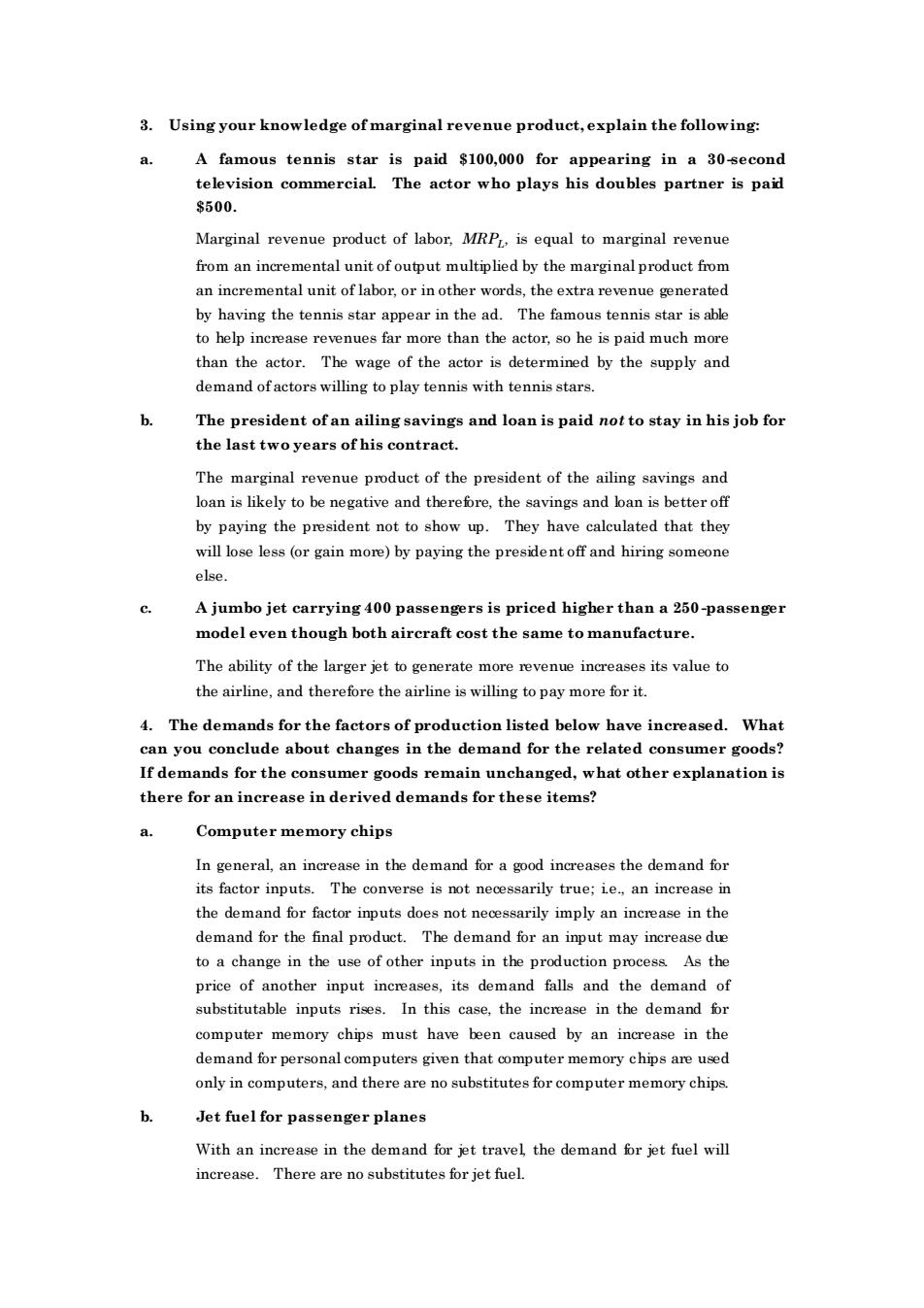
3.Using your knowledge of marginal revenue product,explain the following: a 人m0 one tennin ti pais00Dgi呢40ecom erciaL The actor who partner is paid Marginal revenue product of labor,MRP is equal to marginal revenue from an incremental unit of output multiplied by the marginal product from an incremental unit of labor.or in other words.the extra revenue generated by having the tennis star appear in the ad.The famous tennis star isable to belp more than the actor. than the actor.The wage of the actor is determined by the supply and demand ofactors willing to play tennis with tennis stars. The president of an ailing savings and loan is paid not to stay in his job for the last two years of his contract. The marginal revenue product of the president of the ailing savings and loan is likely to be negative and therefre.the savings and loan is better off by paying the president not to show up.They have calculated that they will lose less (or gain more)by paying the president off and hiring someone else. A jumbo jet carrying 400 passengers is priced higher than a 250-passenger model even though both aircraft cost the same to manufacture. The ability of the larger jet to generate more revenue increases its value to the airline,and therefore the airline is willing to pay more for it. 4.The demands for the factors of production listed below have inc d.What you about nges in a the der and for elated c onsum er goods? If demands for the consumer goods remain unchanged,what other explanation is there for an increase in derived demands for these items? Computer memory chips In general,an increase in the demand for a good increases the demand for its factor inputs.The converse is not necessarily true;ie.,an increase in the demand for factor inputs does not necessarily imply an increase in the demand for the final pro The demand for an nput may increase due to a change in the use of other inputs in the prod uction process As the price of another input increases,its demand falls and the demand of substitutable inputs rises.In this case.the increase in the demand for computer memory chips must have been caused by an increase in the demand for personal computers given that computer mem ory chip are used only in computers,and there are nosu titutes for computer memory chip b. Jet fuel for passenger planes With an increase in the demand for jet travel the demand or jet fuel will increase.There are no substitutes for jet fuel
3. Using your knowledge of marginal revenue product, explain the following: a. A famous tennis star is paid $100,000 for appearing in a 30-second television commercial. The actor who plays his doubles partner is paid $500. Marginal revenue product of labor, MRPL, is equal to marginal revenue from an incremental unit of output multiplied by the marginal product from an incremental unit of labor, or in other words, the extra revenue generated by having the tennis star appear in the ad. The famous tennis star is able to help increase revenues far more than the actor, so he is paid much more than the actor. The wage of the actor is determined by the supply and demand of actors willing to play tennis with tennis stars. b. The president of an ailing savings and loan is paid not to stay in his job for the last two years of his contract. The marginal revenue product of the president of the ailing savings and loan is likely to be negative and therefore, the savings and loan is better off by paying the president not to show up. They have calculated that they will lose less (or gain more) by paying the president off and hiring someone else. c. A jumbo jet carrying 400 passengers is priced higher than a 250-passenger model even though both aircraft cost the same to manufacture. The ability of the larger jet to generate more revenue increases its value to the airline, and therefore the airline is willing to pay more for it. 4. The demands for the factors of production listed below have increased. What can you conclude about changes in the demand for the related consumer goods? If demands for the consumer goods remain unchanged, what other explanation is there for an increase in derived demands for these items? a. Computer memory chips In general, an increase in the demand for a good increases the demand for its factor inputs. The converse is not necessarily true; i.e., an increase in the demand for factor inputs does not necessarily imply an increase in the demand for the final product. The demand for an input may increase due to a change in the use of other inputs in the production process. As the price of another input increases, its demand falls and the demand of substitutable inputs rises. In this case, the increase in the demand for computer memory chips must have been caused by an increase in the demand for personal computers given that computer memory chips are used only in computers, and there are no substitutes for computer memory chips. b. Jet fuel for passenger planes With an increase in the demand for jet travel, the demand for jet fuel will increase. There are no substitutes for jet fuel
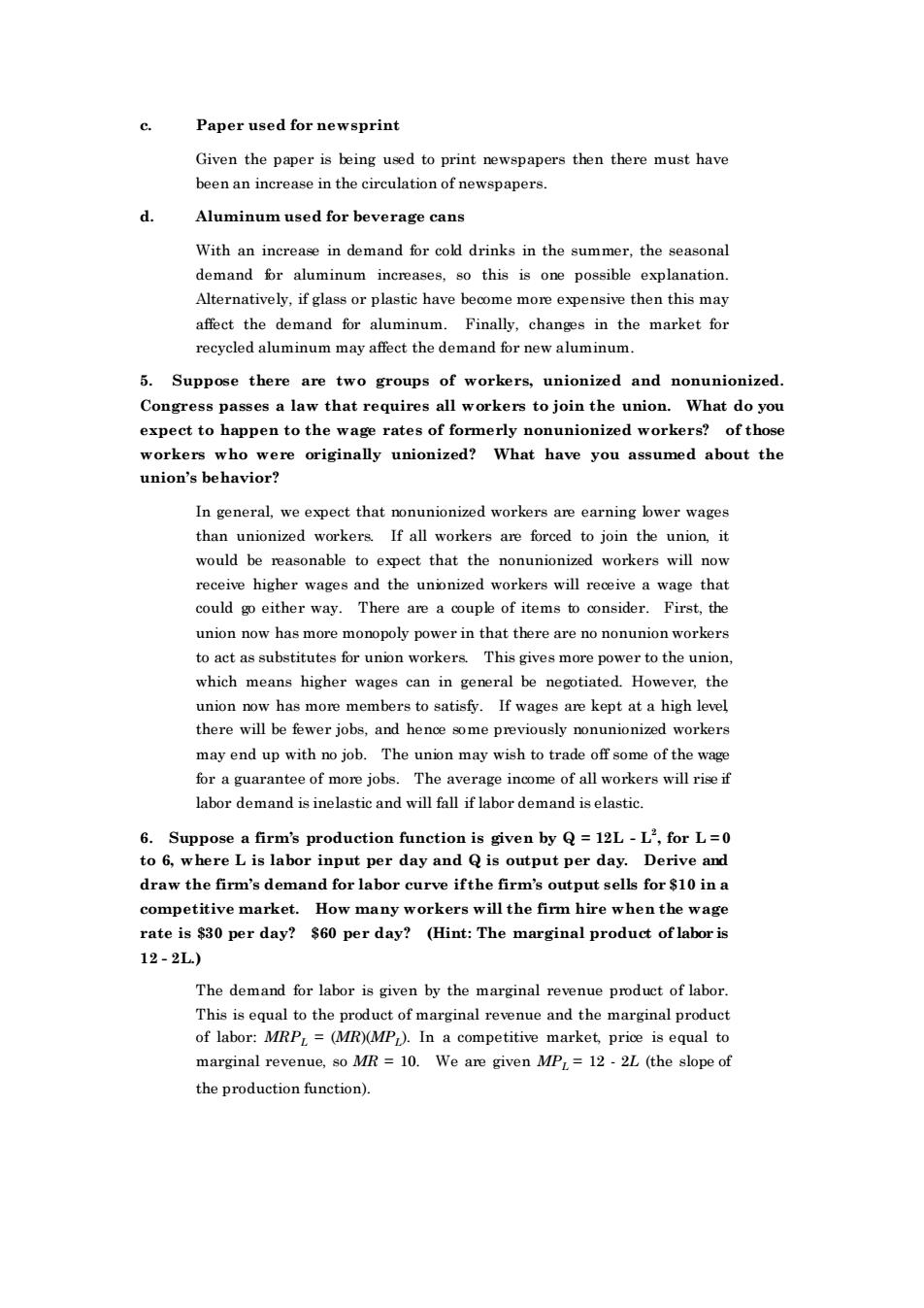
Paper used for newsprint Given the paper is being used to print newspapers then there must have been an in sen the circulation of newspapers. d Aluminum used for beverage cans With an increase in demand for col drinks in the summer,the seasona demand for aluminum increases,so this is one possible explanation Alternatively,if glass or plastic have become more expensive then this may affect the demand for aluminum.Finally,changes in the market for recycled aluminum may affect the demand for new aluminum. 5.Suppose there are two groups of workers,unionized and nonunionized. Congress passes a law that requires all workers to join the union.What do expect to happen to the wage rates of formerly nonunionized workers? workers who were originally unionized?What have you assumed about the union's behavior? In general,we expect that nonunionized workers are earning bwer wages than unionized workers.If all workers are forced to ioin the union.it would be reasonable to expect that the nonunionized workers will now receive highe r wages ar could either way.There are a couple of items to conside a wage tha First,the union now has more monopoly power in that there are no nonunion workers to act as substitutes for union workers This gives more power to the union which means higher wages can in general be negotiated.How er the union n mor If wage kept at a high there will be fewer jobs.and henceome previously nonunionized workers may end up with no job.The union may wish to trade off some of the wage for a guarantee of more jobs.The average income of all workers will rise if labor demand is inelastic and will fall if labor demand is elastic 6. ction function is given byQ=,forL=0 re L is labo r day and Q is output per day.n draw the firm's demand for labor curve ifthe firm's output sells for $10 ina competitive market.How many workers will the firm hire when the wage rate is $30 per day?$60 per day?(Hint:The marginal product of labor is 12-2L) The demand for labor is given by the marginal revenue product of labor. nue and the mar rginal product of labor mpetiti marginal revenue,so MR= 0 We are given MP=12 -2L (the slope of the production function)
c. Paper used for newsprint Given the paper is being used to print newspapers then there must have been an increase in the circulation of newspapers. d. Aluminum used for beverage cans With an increase in demand for cold drinks in the summer, the seasonal demand for aluminum increases, so this is one possible explanation. Alternatively, if glass or plastic have become more expensive then this may affect the demand for aluminum. Finally, changes in the market for recycled aluminum may affect the demand for new aluminum. 5. Suppose there are two groups of workers, unionized and nonunionized. Congress passes a law that requires all workers to join the union. What do you expect to happen to the wage rates of formerly nonunionized workers? of those workers who were originally unionized? What have you assumed about the union’s behavior? In general, we expect that nonunionized workers are earning lower wages than unionized workers. If all workers are forced to join the union, it would be reasonable to expect that the nonunionized workers will now receive higher wages and the unionized workers will receive a wage that could go either way. There are a couple of items to consider. First, the union now has more monopoly power in that there are no nonunion workers to act as substitutes for union workers. This gives more power to the union, which means higher wages can in general be negotiated. However, the union now has more members to satisfy. If wages are kept at a high level, there will be fewer jobs, and hence some previously nonunionized workers may end up with no job. The union may wish to trade off some of the wage for a guarantee of more jobs. The average income of all workers will rise if labor demand is inelastic and will fall if labor demand is elastic. 6. Suppose a firm’s production function is given by Q = 12L - L 2 , for L = 0 to 6, where L is labor input per day and Q is output per day. Derive and draw the firm’s demand for labor curve if the firm’s output sells for $10 in a competitive market. How many workers will the firm hire when the wage rate is $30 per day? $60 per day? (Hint: The marginal product of labor is 12 - 2L.) The demand for labor is given by the marginal revenue product of labor. This is equal to the product of marginal revenue and the marginal product of labor: MRPL = (MR)(MPL). In a competitive market, price is equal to marginal revenue, so MR = 10. We are given MPL = 12 - 2L (the slope of the production function)
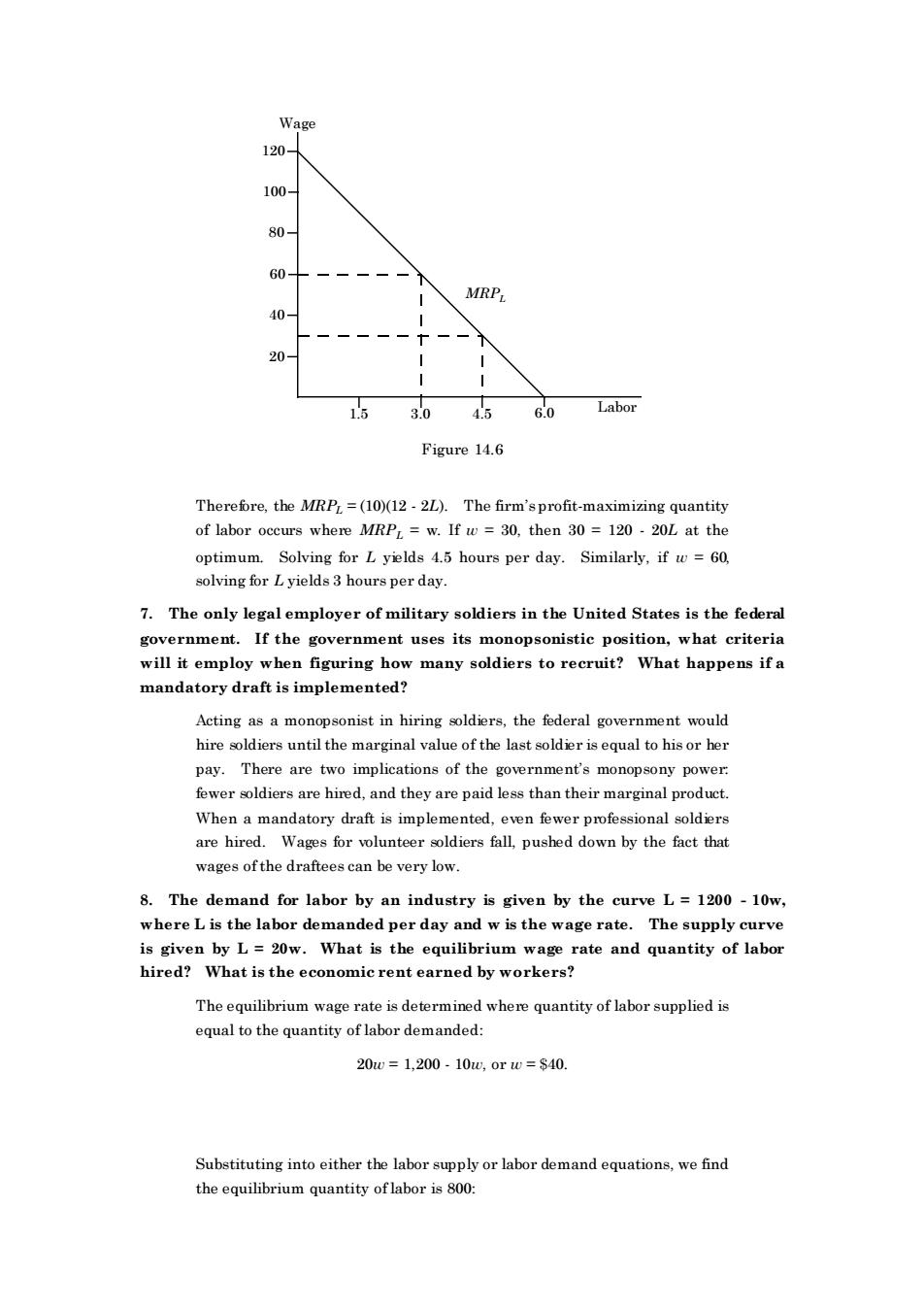
Wag 100- 80 60 MRP 40- 20- 163.046 6.0 Labor Figure14.6 Therefre,the MRP=(10X(12-L).The firm'sprofit-maximizing quantity of labor occurs where MRP.w.If w =30.then 30 120.20L at the optimum.Solving for L vields 4.5 hours per dav.Similarly.if w=60 solving for Lyields3 hours per day. 7.The only legal employer of military soldiers in the United States is the federal governmen If the government uses its monopsonistic position,what criteri will it employ when figuring how many soldiers to recruit? What happens if a mandatory draft is implemented? Acting as a monopsonist in hiring soldiers.the federal government would hire soldiers until the marginal value of the last soldier is equal to his or her ony power. hired,and they are paid ess than n their When a mandatory draft is implemented,even fewer professional soldiers are hired.Wages for wolunteer soldiers fall,pushed down by the fact that wages ofthe draftees can be very low. 8.The demand for labor by an industry is given by the curve L=1200-10w, where L is the labor demanded per day and w is the wage rate.The supply curve a by L 20 What is the rate and quantity of labo What is the economie rent earned by workers? The equilibrium wage rate is determined where quantity of labor supplied is equal to the quantity of labor demanded: 20w=1,200.101,0rw=s40. Substituting into either the labor supply or labor demand equations,we find the equilibrium quantity oflabor is 800:
Wage Labor 20 40 60 80 100 120 1.5 3.0 4.5 6.0 MRPL Figure 14.6 Therefore, the MRPL = (10)(12 - 2L). The firm’s profit-maximizing quantity of labor occurs where MRPL = w. If w = 30, then 30 = 120 - 20L at the optimum. Solving for L yields 4.5 hours per day. Similarly, if w = 60, solving for L yields 3 hours per day. 7. The only legal employer of military soldiers in the United States is the federal government. If the government uses its monopsonistic position, what criteria will it employ when figuring how many soldiers to recruit? What happens if a mandatory draft is implemented? Acting as a monopsonist in hiring soldiers, the federal government would hire soldiers until the marginal value of the last soldier is equal to his or her pay. There are two implications of the government’s monopsony power: fewer soldiers are hired, and they are paid less than their marginal product. When a mandatory draft is implemented, even fewer professional soldiers are hired. Wages for volunteer soldiers fall, pushed down by the fact that wages of the draftees can be very low. 8. The demand for labor by an industry is given by the curve L = 1200 - 10w, where L is the labor demanded per day and w is the wage rate. The supply curve is given by L = 20w. What is the equilibrium wage rate and quantity of labor hired? What is the economic rent earned by workers? The equilibrium wage rate is determined where quantity of labor supplied is equal to the quantity of labor demanded: 20w = 1,200 - 10w, or w = $40. Substituting into either the labor supply or labor demand equations, we find the equilibrium quantity of labor is 800:
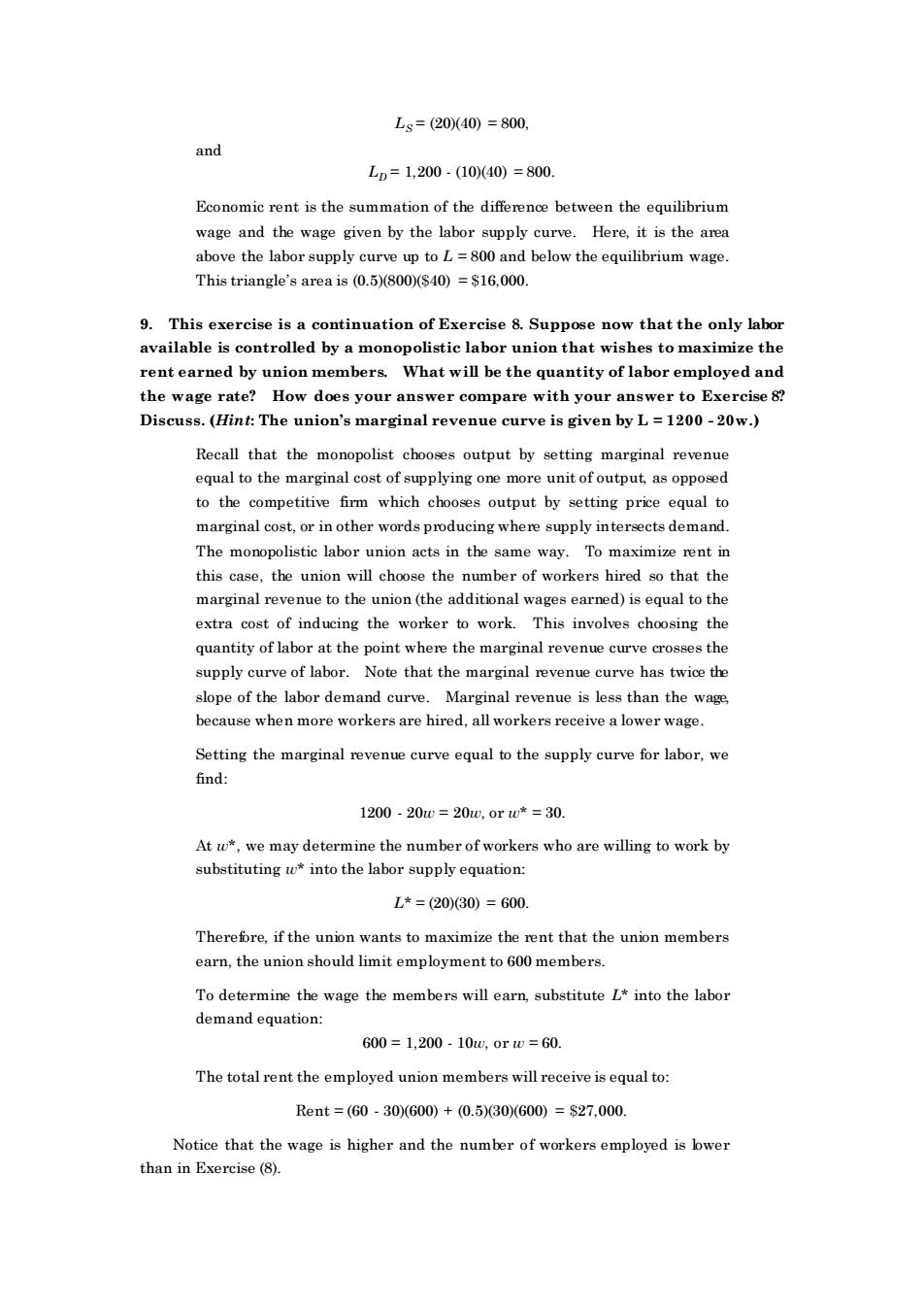
Ls=(20(40)=800. and L=1,200-(10(40)=800. Economic rent is the summation of the difference between the equilibrium wage and the wage given by the labor supply curve.Here,it is the area above the labor supply curve up toL=800 and below the equilibrium wage. This triangle's area is(0.5)(800)($40)=$16.000. 9.This exercise is a continuation of Exercise 8.Suppose now that the only labor available is controlled by a monopolistic labor union that wishes to maximize the rentearned by union members.What will be the quantity of labor employed and the wage r ate? How does your answer compare with your answer to Ex ercise 8 Discuss.(Hint:The union's marginal revenue curve is given by L=1200-20w.) Recall that the monopolist chooses output by setting marginal revenue equal to the marginal cost of supplying one more unit of output,as opposed to the competitive firm which chooses output by setting price equal to marginal cos or in other words producing where supply. The monopolistic acts in the same way. To maximize rent in this case.the union will choose the number of workers hired so that th marginal revenue to the union(the additional wages earned)is equal to the extra cost of inducing the worker to work.This involves choosing the quantity of labor at the point where the marginal revenue curve crosses the supply curve of labor.Note that the argin al revenue urve has twie th slope of the labor demand curve.Marginal revenue is less than the wage because when more workers are hired,all workers receive a lower wage. Setting the marginal revenue curve equal to the supply curve for labor,we find: 1200-20w=20e,0ru*=30. At w*,we may determine the number of workers who are willing to work by substituting into the labor supply equation: L*=(20)(30)=600 Therefre,if theunion wants tomaximize the ent that the unon members earn,the unionshould limit employment To determine the wage the members will earn,substitute into the labor demand equation: 600=1.200.10,ore=60. The total rent the employed union members will receive is equal to: Rent=(60-30600)+(0.5)30)(600)=s27,000. Notice that the wage is higher and the number of workers employed is bwer than in Exercise(⑧)
LS = (20)(40) = 800, and LD = 1,200 - (10)(40) = 800. Economic rent is the summation of the difference between the equilibrium wage and the wage given by the labor supply curve. Here, it is the area above the labor supply curve up to L = 800 and below the equilibrium wage. This triangle’s area is (0.5)(800)($40) = $16,000. 9. This exercise is a continuation of Exercise 8. Suppose now that the only labor available is controlled by a monopolistic labor union that wishes to maximize the rent earned by union members. What will be the quantity of labor employed and the wage rate? How does your answer compare with your answer to Exercise 8? Discuss. (Hint: The union’s marginal revenue curve is given by L = 1200 - 20w.) Recall that the monopolist chooses output by setting marginal revenue equal to the marginal cost of supplying one more unit of output, as opposed to the competitive firm which chooses output by setting price equal to marginal cost, or in other words producing where supply intersects demand. The monopolistic labor union acts in the same way. To maximize rent in this case, the union will choose the number of workers hired so that the marginal revenue to the union (the additional wages earned) is equal to the extra cost of inducing the worker to work. This involves choosing the quantity of labor at the point where the marginal revenue curve crosses the supply curve of labor. Note that the marginal revenue curve has twice the slope of the labor demand curve. Marginal revenue is less than the wage, because when more workers are hired, all workers receive a lower wage. Setting the marginal revenue curve equal to the supply curve for labor, we find: 1200 - 20w = 20w, or w* = 30. At w*, we may determine the number of workers who are willing to work by substituting w* into the labor supply equation: L* = (20)(30) = 600. Therefore, if the union wants to maximize the rent that the union members earn, the union should limit employment to 600 members. To determine the wage the members will earn, substitute L* into the labor demand equation: 600 = 1,200 - 10w, or w = 60. The total rent the employed union members will receive is equal to: Rent = (60 - 30)(600) + (0.5)(30)(600) = $27,000. Notice that the wage is higher and the number of workers employed is lower than in Exercise (8)